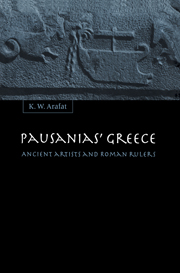Book contents
- Frontmatter
- Contents
- Map of Roman Greece
- Preface and acknowledgements
- List of abbreviations
- Chapter 1 Introduction
- Chapter 2 Pausanias on the past
- Chapter 3 Pausanias on the rulers of Roman Greece 1: introduction, Mummius and Sulla
- Chapter 4 Pausanias on the rulers of Roman Greece 2: Caesar and Augustus
- Chapter 5 Pausanias on the rulers of Roman Greece 3: Nero to Marcus Aurelius
- Chapter 6 Pausanias on Herodes Atticus and other benefactors
- Chapter 7 Conclusions
- Bibliography
- Index of Pausanias passages cited
- Index of other authors and passages cited
- General index
Chapter 4 - Pausanias on the rulers of Roman Greece 2: Caesar and Augustus
Published online by Cambridge University Press: 22 September 2009
- Frontmatter
- Contents
- Map of Roman Greece
- Preface and acknowledgements
- List of abbreviations
- Chapter 1 Introduction
- Chapter 2 Pausanias on the past
- Chapter 3 Pausanias on the rulers of Roman Greece 1: introduction, Mummius and Sulla
- Chapter 4 Pausanias on the rulers of Roman Greece 2: Caesar and Augustus
- Chapter 5 Pausanias on the rulers of Roman Greece 3: Nero to Marcus Aurelius
- Chapter 6 Pausanias on Herodes Atticus and other benefactors
- Chapter 7 Conclusions
- Bibliography
- Index of Pausanias passages cited
- Index of other authors and passages cited
- General index
Summary
The bracketing of Caesar and Augustus in this chapter derives from Pausanias' own view of them as, effectively, the founders of the Roman Empire. He refers to both as basileus (e.g. 5.25.1, 2.17.3 respectively), a use of terminology which is discussed in the following pages, and which clearly places Caesar at the head of the line of sole rulers, the rest of whom belong to the Imperial period, rather than associating him with the earlier, Republican, rulers. Such categorization is more appropriate to the history of Roman Greece than would be a conventional Republican/imperial divide.
JULIUS CAESAR
Unlike Mummius and Sulla, Caesar appears to have been widely regarded as a cultured man: Pliny says that he ‘gave outstanding public importance to pictures by dedicating paintings of Ajax and Medea in front of the temple of Venus Genetrix’, the implication being that he was the first to do so and that he thereby set a fashion (NH 35.26, 7.126). The paintings referred to are by Timomachos of Byzantium, a contemporary of Caesar's (NH 35.136), so this does not represent a pursuit of antiquity. Suetonius refers to him as ‘a most enthusiastic collector of gems, carvings, statues, and pictures by early artists’ (Julius 47), the latter phrase indicating a discriminating preference for antiques. His practice of taking with him on campaign ‘tessellata et sectilia pavimenta’ (Suet. Julius 46) implies interest in art per se, although not necessarily the art of a previous era.
- Type
- Chapter
- Information
- Pausanias' GreeceAncient Artists and Roman Rulers, pp. 106 - 138Publisher: Cambridge University PressPrint publication year: 1996



